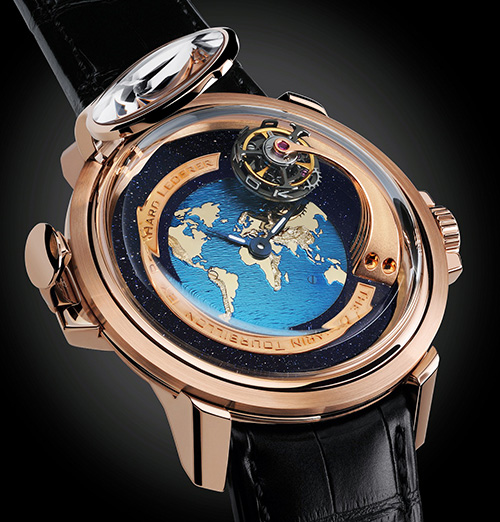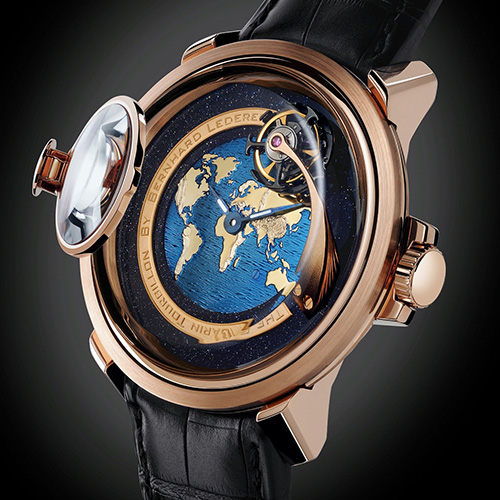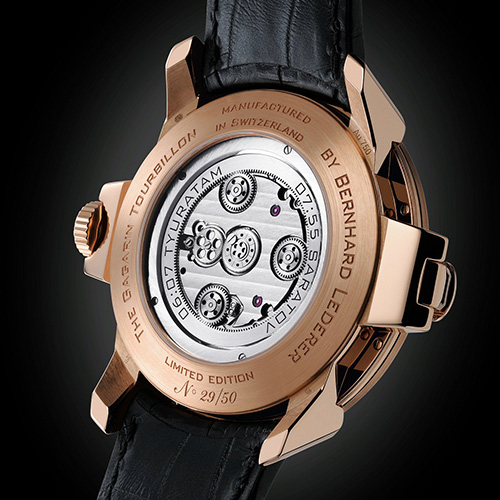2013/07/18
Bernhard Lederer the new "The Gagarin Tourbillon"
The Gagarin Tourbillon celebrates the 50th anniversary of Yuri Gagarin's historic flight in space
Ever since man has walked the earth he has dreamed to fly. In 1961, Yuri Gagarin flew where even the birds could not: into space. The Gagarin Tourbillon by Bernhard Lederer both commemorates and celebrates the 50th anniversary of this historic event.
The Gagarin Tourbillon features a 60-second flying tourbillon that rotates counter clockwise around the dial counter in 108 minutes.
An integrated rotating magnifying glass allows appreciation of details on the dial.
Looking through the loupe to the dial is reminiscent of looking out of the Vostok space capsule towards the earth.
The finely hand finished mechanical movement was entirely developed and produced by Bernhard Lederer in Switzerland.
On the morning of 12 April 1961, a 27-year-old Russian cosmonaut by the name of Yuri Gagarin walked out to the Vostok-1 rocket and was strapped into the pressurised capsule on its nose.
At 06:07 UTC (09:07 Moscow time) the rocket lifted off and just 10 minutes later the final booster rocket burnt out and fell away.
Now floating weightless, Yuri Gagarin became the first man in space. Just over a hour later, retrorockets fired to slow the capsule down for reentry into the earth’s atmosphere.
At an altitude of 7,000 metres (23,000 feet) Gagarin parachuted out of his re-entry module and 10 minutes later landed safely. In just 108 minutes after take-off Gagarin had made a full orbit of the earth.
For the first time, man had left our planet and returned. History was made.
TOURBILLON
In general there are two types of tourbillons (not counting carousels): the classic Breguet tourbillon and the Glashutte flying tourbillon.
Breguet's tourbillon has the system supported between two bearings. All of the forces - and these are considerable for the cage to stop/accelerate/stop/decelerate 2.5 to 4 times per second - throughout the mechanism have to be carried by the tourbillon cage itself so the cage has to be constructed as solidly as possible, while remaining light enough so as not to require excessive energy.
'Solid' and 'light' quickly become mutually exclusive and watchmakers searched for ways of reducing the mass/inertia of the tourbillon cage while at the same time ensuring that it is strong enough to support the considerable forces going through it.
In 1920, professor Helwig, who was an instructor at the watchmaker’s school in Glashütte/Dresden in Germany, developed a system that was essentially different from those of the Breguet style. Helwig's construction did not support the tourbillon cage between two bearings, but above the two bearings guiding the pinion for teh second hand. You can visualize this by imagining replacing the second hand with a tourbillon cage and, like the second hand the cage is only supported from one side, i.e. the bottom in this case.
In Helwig's flying tourbillon, the cage no longer is required to support the forces going through the system, but has only to carry the outer fixation of the hairspring and the upper bearing of the balance staff. This allows the flying tourbillon cage to be built extremely lightly, which save lots of weight, requires less energy and makes less demands of the escapement. The latter is important because it is the pallet of the anchor that is responsible for slowing down and dissipating the energy of the rotating tourbillon cage.
In the construction of the Gagarin Tourbillon movement, Bernhard Lederer chose to use a flying tourbillon so as to offer a longer lasting calibre: less energy generates less friction, there is less wear and parts are longer lasting. The monumental bridge is a decorative element providing direction to the orbital rotation. It does not support the tourbillon, although it does provide a degree of shock protection. The movement will work perfectly well without that sweeping bridge.
The Gagarin Tourbillon features a 60-second flying orbital tourbillon that rotates counterclockwise (symbolising east) 360° around the dial in 108 minutes, which is the time Gagarin took to orbit the earth in the Vostok capsule.
The tourbillon appears suspended by a sweeping bridge inspired by the large 25 m (82 ft) commemorative statue at Gagarin’s landing site near Engels.
The tourbillon cage is formed by the word “VOSTOK” spelt vertically and curved around its perimeter.
CASE AND MAGNIFYING GLASS
The case of the Gagarin Tourbillon is in high grade 950 platinum and incorporates an integrated rotating magnifying glass that allows more detailed appreciation of the tourbillon and details on the dial.
The magnifying glass is locked in place by a catch inspired by a hatch on the Vostok capsule.
MOVEMENT
The finely hand finished mechanical movement of the Gagarin Tourbillon is manual winding with three mainspring barrels providing a power reserve of approximately 80 hours.
The complex movement with 264 components and 35 jewels was entirely designed, developed and manufactured by Berhnard Lederer in Switzerland.
DIAL
The dial of the Gagarin Tourbillon is hand-engraved in solid gold with the colour of the oceans either in galvanic blue or black, with a scintillating outer dial in synthetic black diamond.





The Gagarin Tourbillon is a limited edition of 50 pieces in platinum featuring a unique flying tourbillon. Unique 60-second tourbillon orbiting the dial counter clockwise in 108 minutes; hour and minutes; manual winding mechanical movement.
Movement
- Mechanical manual winding movement developed and produced in-house by Bernhard Lederer in Switzerland
- Tourbillon cage: In titanium and forming the word “VOSTOK”
- Dimensions: 38 mm x 11.5 mm
- Balance frequency: 28, 800 bph/4 Hz
- No. of components: 264
- No. of jewels: 35
- No. of barrels: 3
- Power reserve: 80 hours
Case
- Case Featuring integrated rotating magnifying glass
- Case material: Platinum 950
- Dimensions: 42 mm x 15 mm (case), 46.5 mm with magnifying glass ring
- Water resistant: 30 meters/3 ATM
- Sapphire crystals: Sapphire crystal and sapphire crystal display
Dial
- Indications: Hours and minutes
- Map of the world hand engraved in solid gold with tourbillon orbiting in 108 minutes (Gagarin orbited the earth in 108 minutes)
Strap & Buckle
- Black hand-stitched alligator strap with platinum tang buckle


